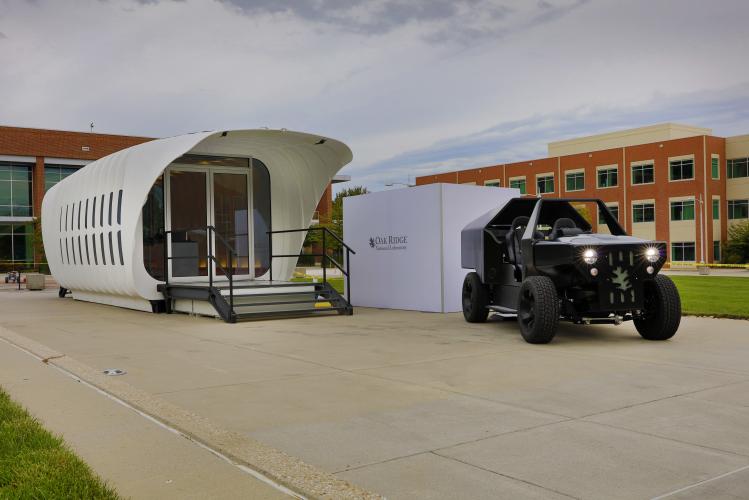
A research demonstration unveiled today at the Department of Energy’s Oak Ridge National Laboratory combines clean energy technologies into a 3D-printed building and vehicle to showcase a new approach to energy use, storage and consumption.
The Additive Manufacturing Integrated Energy (AMIE) demonstration, displayed at DOE’s Office of Energy Efficiency and Renewable Energy Industry Day event, is a model for energy-efficient systems that link buildings, vehicles and the grid.
An ORNL team worked with industrial partners to manufacture and connect a natural-gas-powered hybrid electric vehicle with a solar-powered building to create an integrated energy system. Power can flow in either direction between the vehicle and building through a lab-developed wireless technology. The approach allows the car to provide supplemental power to the 210-square-foot house when the sun is not shining. Watch an animation of the energy flow here:https://youtu.be/afITvjudnoc.
The demonstration also showcases additive manufacturing’s rapid prototyping potential in architecture and vehicle design; the car and house both were built using large-scale 3D printers.
The 38x12x13-foot building was designed by architecture firm Skidmore, Owings, and Merrill (SOM) through the University of Tennessee-ORNL Governor’s Chair for Energy and Urbanism. It was assembled by Clayton Homes, the nation’s largest builder of manufactured housing. Connecting the house to the 3D-printed vehicle demonstrates the concept of integrating two energy streams, buildings and transportation, which typically operate independently.
“Working together, we designed a building that innovates construction and building practices and a vehicle with a long enough range to serve as a primary power source,” said ORNL’s Roderick Jackson, who led the AMIE demonstration project. “Our integrated system allows you to get multiple uses out of your vehicle.”
Advanced building controls and power management maximize the efficiency of the system’s components. The project’s energy control center manages the system’s electrical demand and load by balancing the intermittent power from the building’s 3.2-kilowatt solar array with supplemental power from the vehicle.
ORNL researchers hope their integrated approach to energy generation, storage and consumption will introduce solutions for the modern electric grid, which faces challenges ranging from extreme weather events to how best to incorporate growing renewable energy use, particularly as the transportation sector transitions away from fossil fuels.
“We’re looking at large community issues from the single-unit level,” said ORNL’s Martin Keller, associate laboratory director for Energy and Environmental Sciences. “Our research provides solutions on a small scale, which will translate to a significant reduction in energy use and an increase in cost savings when ramped up to a national, and even global, level.”
Read more: ORNL integrated energy demo connects 3D-printed building, vehicle
The Latest on: Additive Manufacturing Integrated Energy
[google_news title=”” keyword=”Additive Manufacturing Integrated Energy” num_posts=”10″ blurb_length=”0″ show_thumb=”left”]
via Google News
The Latest on: Additive Manufacturing Integrated Energy
- nLIGHT, Inc. (NASDAQ:LASR) Q1 2024 Earnings Call Transcripton May 6, 2024 at 7:26 am
Q1 2024 Earnings Call May 5, 2024 nLIGHT, Inc. isn’t one of the 30 most popular stocks among hedge funds at the end of the third quarter (see the details here). Operator: Hello and welcome to the ...
- Godrej & Boyce deployed over 80 RPA bots for automation, resulting in enhanced productivity and reduced errorson May 5, 2024 at 11:10 pm
In this interview Amit Chawla, Head of Digital Projects at Godrej & Boyce, discusses the strategic integration of robotics and automation to address societal challenges while emphasizing ...
- Q1 2024 nLIGHT Inc Earnings Callon May 3, 2024 at 12:13 am
We developed innovative products for a nascent but fast-growing metals additive manufacturing ... integrated business model provides us with significant competitive differentiation in this market. Our ...
- Through the doors: Inside the AM strategy at GE Aerospaceon April 24, 2024 at 5:47 am
TCT Group Content Manager Sam Davies reports back from a visit to GE Aerospace's Additive Technology Center (ATC) in Cincinnati, Ohio.
- Here are the 30+ startups showcasing at HAX’s May 1 Demo Dayon April 22, 2024 at 2:39 pm
The list includes more than 30 companies, across climate, manufacturing, computing, health and energy. We’ve got ... has developed a unique approach to additive manufacturing that enables ...
- Additive Manufacturing For Batteries Of The Future: Will 3D Printing Transform Battery Making?on January 30, 2023 at 5:53 am
energy storage applications. Sakuú says lithium-ion batteries will no longer be limited to rectangles, cylinders, or pouches and can instead be integrated into products enabling designers to fit ...
- AI and lasers light the way to a manufacturing revolutionon August 10, 2022 at 8:31 am
and a physical production process are integrated, with a built-in feedback mechanism allowing for fully automated control. Additive manufacturing, perhaps better known as 3D printing, is a prime ...
- Using additive manufacturing to shape the futureon August 12, 2020 at 5:59 am
Gain knowledge of properties of materials, the traditional manufacturing methods and how AM can be integrated into these process • Combine these skills to gain a better understanding of the advantages ...
- Research & Innovationon March 7, 2017 at 7:47 pm
Nanomanufacturing Center: The Center's mission is the creation of environmentally benign manufacturing processes that enable commercialization of nanotechnology products. Nuclear Security & Safeguards ...
- Advanced manufacturing innovation and skillson January 18, 2014 at 11:50 pm
It focuses on high-level apprentice and CPD training for sectors such as aerospace, energy and ... Machining, Integrated manufacturing, Composite Manufacturing, Castings, Design & prototyping, ...
via Bing News









